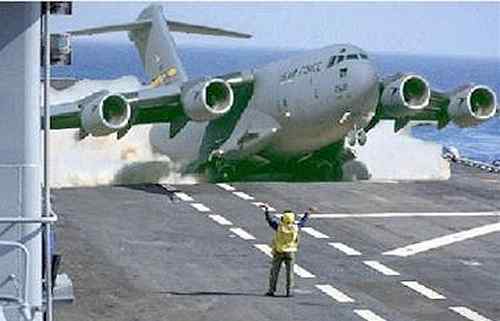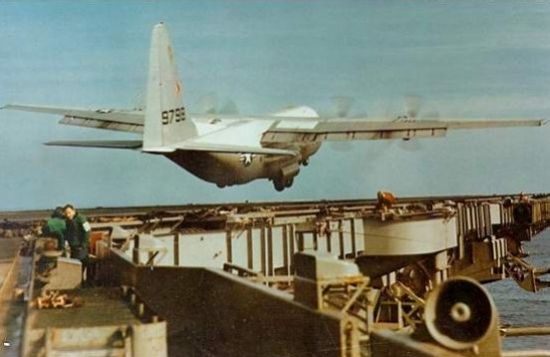
Now THERE'S a perspective shot for ya...
Posted on 08/04/2003 11:48:27 AM PDT by Ed Straker
Posted on Mon, Aug. 04, 2003
Factors may be on side of C-5As
Air Force may be unable to retire aging aircraft as quickly as some want
By Gene Rector
Telegraph Staff Writer
ROBINS AIR FORCE BASE - A gang of brutal realities may be the strongest ally Robins Air Force Base has in preserving its C-5A workload - at least for the next several years.
Some Air Force officials would prefer to retire the aging, 30-year-old C-5A fleet of 74 aircraft and buy more C-17s, the nation's newest strategic airlifter. That would leave only 50 newer C-5Bs, and that would significantly reduce the 960 jobs Robins now devotes to periodic overhaul of the huge cargo aircraft.
Gen. John Handy said in a July 7 Air Force Times article that the C-5A "would not survive a review by the air worthiness board." Handy heads Air Mobility Command, the Air Force agency responsible for operating all airlift resources. The board will likely meet this fall to see if updates planned for the C-5 make economic sense for the C-5A.
About $13 billion is programmed for the updates - to heal nagging reliability problems, provide modern navigation and flight controls and install more efficient engines.
"The crux of the decision is whether to spend about $70 million per C-5A or buy new C-17s," said Al Fatkin, the C-5 deputy system program manager at Robins. The C-17 price tag is about $240 million per aircraft.
AMC referred questions to the Pentagon, and a response from the Pentagon was not available last week. However, Gordon Trowbridge, who authored The Times article, stands by his story.
"Clearly, the Air Force would rather have more C-17s," said Trowbridge, whose story was based on Handy's comments to the defense writers group in Washington, D.C.
"Gen. Handy said we're starting up the air worthiness board and the first aircraft we're going to look at is the C-5A. He said, 'Our hypothesis is that it will not make it through the board.' "
Trowbridge said Air Force Secretary James Roche has similar convictions. "In fact, in some ways he has said it more definitively," he said.
Handy told The Times he needs 222-plus C-17s. "But the 'plus' is going to depend on how many C-5s go away," he was quoted as saying.
Making the C-5 "go away" may be difficult, at least in the short term:
• U.S. forces already suffer from significant airlift shortfalls, deficiencies underscored during the recent Iraqi war.
• Robins data show the C-5A can be safely flown through the year 2040.
• The C-5 can do things the C-17 can't, including hauling more of the Army's heavy tanks and fighting vehicles.
• Boeing's C-17 production could not quickly fill the void should the Air Force decide to retire the C-5A.
But the most conclusive support for the C-5A is contained in Congressional language for the 2004 Defense Authorization Act. Both the House and Senate approved $131 million to begin the C-5 modifications - $40 million more than the Air Force requested.
However, the Senate version restricted 2004 funding to navigation and flight control upgrades for the C-5A only.
The House did not restrict the funding but it prohibited the Air Force Secretary from reducing the C-5 fleet below 112 aircraft until a fully modified C-5A - with airframe and engine updates - has been tested and a report filed with Congress.
The C-5 fleet now has 126 aircraft, although 14 of the oldest C-5As will be retired in 2004 and 2005 in a move unrelated to the air worthiness board process.
"Even if the air worthiness board decides to get rid of the C-5A as fast as humanly possible, that process could take decades," said Bill Johnson, U.S. Rep. Jack Kingston's chief of staff. Kingston is a Republican congressman from Georgia's 1st District.
"We know that the Defense Department's mobility plan is short cargo miles," said Johnson. "So, everything they do has to be about making sure they don't dig the hole deeper. I think Congress is going to stay on the side of the C-5 as long as possible. And one of the things we want to see is what a C-5A upgrade will give us. That will be the tipping point."
Clyde Taylor, military legislative assistant for Sen. Saxby Chambliss, R-Ga., said congressional involvement in the C-5 decision is good news for Robins.
"Congress is taking an active role in slowing down Air Force's plans until they go through a couple of steps to make sure that retiring C-5As is the right decision," he said. "Some people say that if we keep all the C-5s and build all the C-17s we can, we still won't have enough airlift. Given that, we shouldn't be retiring C-5As."
Johnson said he understands the desire for a new aircraft. "I guarantee there are people in AMC who want a new plane," he said. "Certainly the contractor wants one. The pilots want one. But we're really at the beginning of the debate about what we should do with the C-5A."
The Kingston aide said the C-5 will, of course, be retired some day. "And that will happen before the C-17 is retired," he said. "It's just a question of when those lines begin to cross. I don't think that's going to happen any time soon. We're at the infant stage of this right now."
This is stated as fact, without a source. Fact is that we moved a mountain of materiel and I never heard one peep about us not having enough lift capacity. Any takers?
Michael

Now THERE'S a perspective shot for ya...
More "what's good for my district" military analysis.

From the local paper, the Virginian-Pilot. This actually happened a few months ago at NAS Norfolk. C5 comes in about 1am, pilot is unfamiliar with the runway layout and manages to get this monstrosity stuck. Since the runway extends out over 564, the main route to NAS Norfolk, morning rush hour traffic got quite an eyeful on the way to the base. Took most of the day to get it back on track cause they had to wait for equipment from Dover AFB to move the damned thing. *L*
And lookie here: same plane, same dust, same shadows, no carrier
What C-141Bs? Some have already been retired. The active duty fleet is scheduled to be retired by late this year or early next year. Guard and Reserve will get the "low mileage" birds, but will retire those by end of 2006, according to current plans. Some C-141 units have already stood down over the past year or two.
Remember Operation Anaconda in Afghanistan? The Army had no artillery in country and only limited attack helicopters--I think it was 8(?). As a result, we were unable to successfully suppress enemy fire upon the initial insertion and we lost helicopters and American lives. Further, fixed wing air by nature of its short loiter time, limited flexibility, and inability to work in bad weather was not able to provide the promised support to the ground troops, so when Taliban or Al Qaeda were spotted outside the range of infantry weapons, they often could not be engaged and most eventually got away. The reason for not having the heavy stuff was insufficient airlift.
However there are quite authentic pictures of a C-130 taking off AND landing on a carrier. A former Marine C-130 and chopper pilot who just retired from our office told me he flew that C-130 on many occasions, but not for the carrier trials.

More pictures, including videos, at: Aerospaceweb
Why do you think we did that kabooki dance with the turks over the 4th ID? If we could have flown them in, we would have, but instead we had to land them in Turkey and let them drive to Iraq. Then we had to move them, or more properly their equipemnt, from the Med to the Indian Ocean/Arabian Sea, after the Turks said no dice. If we could have flown them around, into Kuwait, there'd have been way more boots, wheels and treads on the ground during the earliest weeks of the fighting.
Disclaimer: Opinions posted on Free Republic are those of the individual posters and do not necessarily represent the opinion of Free Republic or its management. All materials posted herein are protected by copyright law and the exemption for fair use of copyrighted works.